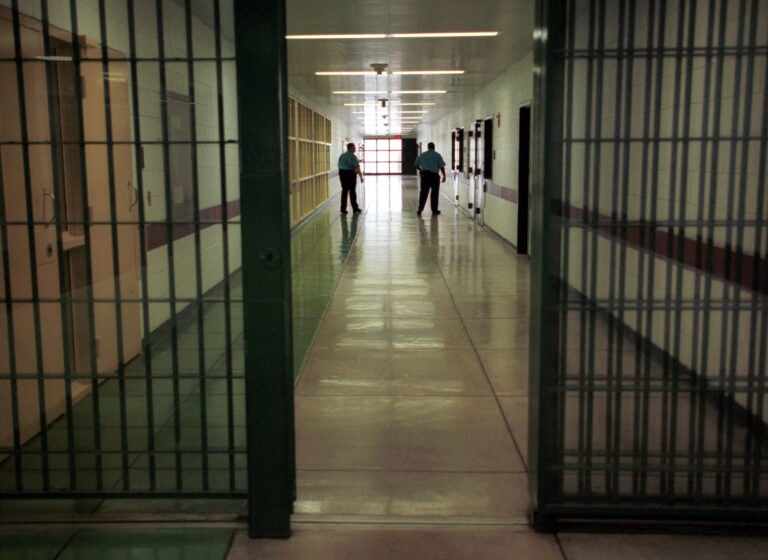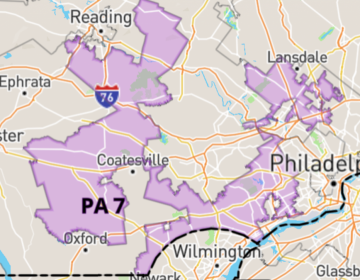Pa. commission votes to scale back ‘prison gerrymandering’ reform made last month
A commission added a carveout to count those serving sentences that will end after April 1, 2030 — the date of the next census — in prison districts.

Officers at the Cumberland County Prison walk the halls in Carlisle, Pa. (AP Photo/Carolyn Kaster)
The commission charged with redrawing Pennsylvania’s House and Senate maps has backtracked on a provision of a major “prison gerrymandering” decision it made last month — voting to narrow the number of state prisoners it will count as residents of their home district, rather than the one where they’re locked up.
Last month, the five-member Legislative Reapportionment Commission voted to count nearly all of the roughly 40,000 people in Pennsylvania’s state correctional institutions as residents of the legislative district where they lived pre-prison, rather than as residents of the district where their prison is located.
The only exceptions were for people who hadn’t lived in Pennsylvania before they were incarcerated — who wouldn’t be counted as residents of any district — and people serving life sentences. The Penn State Data Center, which conducts census data analysis for the commission, estimated there were about 4,000 lifers carved out.
Now, the commission is adding another carveout for those serving sentences that will end after April 1, 2030 — the date of the next census. The change, spearheaded by the Republicans on the commission who never supported changing how the commonwealth counts incarcerated people, will keep about another 3,000 prisoners from being counted in their home districts.
Senate Majority Leader Kim Ward (R-Westmoreland), who introduced the resolution for the rollback, called it “a common-sense compromise.”
“Prisoners are, in fact, physically located in the districts where they’re incarcerated,” said Ward, whose district includes SCI Greensburg. “They are not only utilizing the facilities, utilities, and resources in the districts where they reside, they are also utilizing the representational bandwidth, the representational capacity of the senators and representatives of the districts where the prison is located.”
House Minority Leader Joanna McClinton (D-Philadelphia), who had led the push to count prisoners in their home districts, rebutted that she thought Ward’s new resolution was just “an attempt of a do-over.”
“The rationale for treating incarcerated individuals as residents of their home communities, rather than the places where they’re incarcerated, [is] because they do not voluntarily decide to live in those places and cannot in fact establish a legal domicile,” she added. “The length of a prisoner’s minimum sentence does not change this reality.”
But McClinton and her fellow Democratic member, Senate Minority Leader Jay Costa (D-Allegheny), were overruled by the committee’s designated nonpartisan tiebreaker, Mark Nordenberg. He sided with Ward and her fellow GOP member, House Majority Leader Kerry Benninghoff (R-Centre).
Nordenberg, the former chancellor of the University of Pittsburgh who now chairs the school’s institute of politics, has stressed that he wants to keep partisan considerations as far from his reasoning as possible. In August, when the commission first took up the prison population issue, he sided with the Democrats. This time around, he went with the Republicans, with the logic that the lengthier sentences warranted being treated the same as the life sentences.
“Is it reasonable, is it thoughtful, is it advanced for what I would consider to be appropriate reasons?” he asked of the rollback. “My answer to that question is yes.”
The debate has taken on a partisan flavor because of the demographic realities of counting prisoners. Populous, Democratic-leaning cities feed Pennsylvania’s incarcerated population by large majorities, while most prisons are located in sparsely populated rural, conservative-leaning districts.
If prisoners are counted as though they live in those districts, it gives those regions more political power. A recent Villanova University Study found that if prisoners were counted in their home districts during legislative map-drawing, the average Black Pennsylvanian would gain 353 new voters in their district and the average white Pennsylvanian would lose 59. Four districts would become legally too small, and four would become too big, leading to a likely Democratic advantage.
Democrats and many good-government advocates — like the Committee of Seventy, Fair Districts Pennsylvania, and the League of Women Voters — have said their aims aren’t explicitly partisan, just that it’s unfair to reallocate any measure of political power based on the arbitrary location of prisons. The commission’s Republican members have made a similar case, pitching this new rollback as an effort to acknowledge the role prisons play in the communities that house them.
In the first round of the “prison gerrymandering” debate, Nordenberg said he had concerns about slowing down the commission’s work — already delayed due to late census numbers — but ultimately decided Pennsylvania should change the way it counted prisoners.
Lumping them in with communities they didn’t choose to go to, and of which they can never meaningfully be part, he said in August, creates “a basic issue of fairness.”
“It distorts the reapportionment process by giving certain classes of voters — in this case, voters living in districts with state correctional institutions — votes that carry more weight than the votes cast in districts that do not include such institutions,” he added.
A month later, Nordenberg said he still believed all that, but that Republicans’ proposal to roll back the number of prisoners reallocated under the new approach was consistent with his previous decision. Republicans, he said, had been unhappy with the previous decision to change how Pennsylvania counts prisoners, and so had convinced him of “an agreeable way to move forward.”
Nordenberg also said scale was a factor in his reasoning. According to the Penn State Data Center, this decision affects fewer prisoners than did the commission’s previous big compromise: Democrats’ decision to keep counting people with life sentences as residents of their prison, at the behest of Republicans.
That carveout affected about 3,954 inmates, Nordenberg said. This new one affects 3,046.
Carol Kuniholm, who heads the redistricting reform group Fair Districts PA, said she and others who had pushed to end so-called “prison gerrymandering” were disappointed by Nordenberg’s decision.
Kuniholm had opposed Democrats’ initial decision to compromise by excluding lifers from being counted in their home districts. Pennsylvania, she noted, has the second largest population of people serving life sentences in the country, behind Louisiana. She said Nordenberg using that compromise as an “excuse” to make another compromise is “troubling.”
“The numbers are relatively small,” she said of the people who will now be counted as residents of their prisons, “but the message of disrespect it sends to impacted individuals, families, and communities is a large one.”

Get more Pennsylvania stories that matter
WHYY is your source for fact-based, in-depth journalism and information. As a nonprofit organization, we rely on financial support from readers like you. Please give today.








